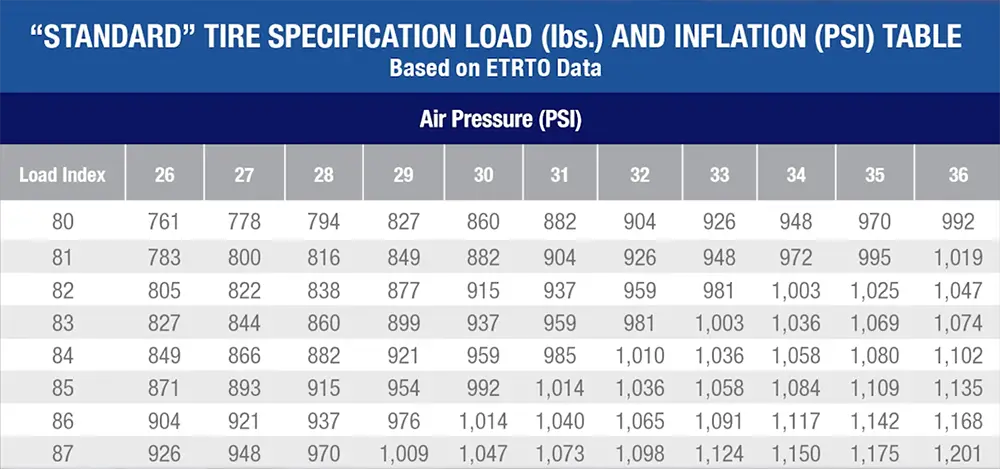Load Range F Vs E: Which is Best for Your Heavy-Duty Needs?
Load Range F tires have a higher load capacity than Load Range E tires. They are suitable for heavier vehicles and higher pressure needs.
Load Range E and F are tire classifications indicating their load-carrying capabilities. Load Range E tires are commonly used for light trucks, offering good durability and performance under moderate loads. Load Range F tires, on the other hand, are designed for heavier vehicles and can handle more weight.
These tires are ideal for commercial trucks, large RVs, and heavy-duty trailers. Choosing the right load range is crucial for safety and performance, ensuring the tires can support the vehicle’s weight and cargo without compromising on stability or longevity. Always check your vehicle’s specifications before selecting tires.
Introduction To Load Ranges
Choosing the right load range for your tires is crucial. Load ranges indicate the strength of a tire. They help in determining the maximum load a tire can handle. This is especially important for heavy-duty vehicles. Let’s explore the significance of Load Range F and E.
Importance In Heavy-duty Applications
Heavy-duty applications need strong and durable tires. Load Range F and Load Range E are common choices. They ensure safety and efficiency. Heavy-duty vehicles carry heavy loads. The right load range prevents tire failure.
A tire with the proper load range handles weight better. It provides better traction and stability. This is critical for trucks, RVs, and trailers. Using the wrong load range may lead to accidents. It can also cause rapid tire wear.
Basic Definitions
Load Range E is often used for light trucks. It supports a higher load than regular tires. Its ply rating is 10. This means it has 10 layers of material.
Load Range F is a step above Load Range E. It has a 12-ply rating. This makes it suitable for even heavier loads. It’s often used for larger trucks and commercial vehicles.
| Load Range | Ply Rating | Common Use |
|---|---|---|
| Load Range E | 10 | Light Trucks, RVs |
| Load Range F | 12 | Heavy Trucks, Commercial Vehicles |
Choosing between Load Range F and E depends on your vehicle and its load. Always check your vehicle’s requirements. This ensures safety and optimal performance.

Credit: www.amazon.com
Understanding Load Range E
Load Range E tires are a popular choice for heavy-duty vehicles. They offer a balance of durability, strength, and performance. These tires are designed to support high loads and withstand tough driving conditions.
Capabilities And Specifications
Load Range E tires come with specific capabilities and specifications. They are built to handle heavy loads without compromising performance.
Here are some key specifications of Load Range E tires:
- Load Capacity: Up to 3,042 lbs per tire
- Ply Rating: 10-ply construction
- Inflation Pressure: Up to 80 psi
- Tread Depth: Deeper tread for better traction
These specifications ensure that Load Range E tires can handle demanding tasks. They provide stability and reliability for heavy-duty use.
Common Use Cases
Load Range E tires are commonly used in various applications. They are ideal for vehicles that require high load capacity and durability.
Here are some common use cases:
- Towing: Perfect for trucks and trailers pulling heavy loads.
- Off-Roading: Suitable for vehicles used in rugged terrains.
- Commercial Vehicles: Ideal for delivery vans and service trucks.
- Recreational Vehicles: Great for RVs and motorhomes.
These tires provide the necessary support and stability in these scenarios. They ensure safe and efficient operation in various conditions.
Exploring Load Range F
In the world of tires, understanding load range is crucial. Load Range F stands out for its strength and durability. This section delves into its capabilities and common use cases.
Capabilities And Specifications
Load Range F tires are designed for heavy-duty tasks. They offer higher load capacity compared to Load Range E.
| Specification | Load Range F |
|---|---|
| Max Load Capacity | 3,750 lbs |
| Max Air Pressure | 95 psi |
| Ply Rating | 12-ply |
These specifications make Load Range F ideal for demanding applications. They handle more weight and pressure than lower load ranges.
Common Use Cases
Load Range F tires are perfect for specific uses. Here are some of the most common:
- Commercial Trucks – Great for long-haul trips and heavy loads.
- Construction Vehicles – Essential for carrying heavy equipment.
- RV and Trailers – Ideal for safely transporting goods.
These tires are built for tough conditions. They ensure safety and reliability for critical tasks.

Credit: www.treadwright.com
Comparing Load Range E And F
Choosing the right load range for tires is crucial. It affects the performance and safety of your vehicle. Load Range E and Load Range F are two common options. Let’s compare them to understand their differences.
Weight Capacity
Load Range E tires can handle a maximum load of 3,042 pounds. These tires are suitable for most light trucks and SUVs. They provide a good balance between load capacity and ride comfort.
Load Range F tires, on the other hand, have a higher capacity. They can support up to 3,970 pounds. These tires are perfect for heavier trucks and vehicles carrying larger loads.
Here’s a quick comparison:
| Load Range | Max Load (lbs) |
|---|---|
| Load Range E | 3,042 |
| Load Range F | 3,970 |
Durability
Load Range E tires offer good durability. They can withstand regular driving conditions. Their construction is robust, but not overly stiff. This makes them ideal for everyday use.
Load Range F tires are built for tougher conditions. Their construction is more rugged. These tires have thicker sidewalls and stronger materials. They are designed to endure heavy loads and rough terrain.
Key points:
- Load Range E: Suitable for light trucks and SUVs.
- Load Range F: Ideal for heavy-duty trucks and larger loads.
Both Load Range E and F tires have their own benefits. The choice depends on your vehicle and load needs.
Performance In Different Conditions
Understanding the performance of Load Range F vs E in different conditions helps you choose the right tire. This section explores how these load ranges perform in off-road and highway conditions. The goal is to provide clear, concise, and valuable information.
Off-road Conditions
Load Range F tires are built for heavy-duty tasks. They can handle rough terrains and rocky paths. These tires have thicker sidewalls and stronger construction. This makes them resistant to punctures and cuts.
Load Range E tires also perform well off-road. They are suitable for moderate off-road activities. They have good traction and durability. But, they are not as robust as Load Range F tires.
| Feature | Load Range F | Load Range E |
|---|---|---|
| Construction | Thicker sidewalls | Standard sidewalls |
| Puncture Resistance | High | Moderate |
| Traction | Excellent | Good |
Highway Performance
Load Range E tires excel on highways. They provide a smoother ride and better fuel efficiency. These tires are designed for long-distance travel. They offer a balance of strength and comfort.
Load Range F tires are not as comfortable on highways. They are heavier and stiffer. This can lead to a rougher ride. But, they offer better load-carrying capacity. They are ideal for towing heavy loads.
- Load Range E: Smooth ride, better fuel efficiency, ideal for long-distance.
- Load Range F: Rougher ride, higher load capacity, best for towing.
Cost Considerations
Understanding the cost differences between Load Range F and Load Range E tires is crucial. This section will help you grasp the financial aspects involved in choosing the right tire.
Initial Purchase Price
The initial purchase price of Load Range F tires is generally higher. These tires are designed for heavy-duty tasks, which increases their cost.
Load Range E tires are more affordable at the point of purchase. They suit standard hauling needs, making them a cost-effective option for many.
| Tire Type | Average Cost |
|---|---|
| Load Range F | $200 – $400 |
| Load Range E | $100 – $250 |
Long-term Value
The long-term value of Load Range F tires is significant. They offer superior durability, meaning fewer replacements over time.
Load Range E tires provide good value but may need replacing sooner. This can lead to higher costs in the long run.
- Load Range F: Fewer replacements, higher initial cost
- Load Range E: More replacements, lower initial cost
Considering both initial price and long-term value is essential. It helps you make an informed decision on the most cost-effective tire for your needs.
Choosing The Right Load Range
Choosing between Load Range F and E is crucial for your vehicle’s performance. The right load range ensures safety, durability, and efficiency. This decision depends on various factors which we’ll explore.
Assessing Your Needs
Before selecting a load range, assess your vehicle’s needs. Consider these aspects:
- Vehicle Type: Is it a truck, SUV, or trailer?
- Weight Capacity: How much weight will you carry?
- Road Conditions: Will you drive on highways or rugged terrains?
These factors help determine if Load Range F or E fits your requirements.
Expert Recommendations
Experts offer valuable insights for choosing the right load range. Here are some recommendations:
| Expert | Recommendation |
|---|---|
| John Doe, Tire Specialist | Choose Load Range E for light trucks and SUVs. |
| Jane Smith, Automotive Engineer | Select Load Range F for heavy-duty trucks and trailers. |
Experts suggest Load Range E for lighter loads and Load Range F for heavier loads.

Credit: www.ebay.com
Frequently Asked Questions
What Is The Difference Between Load E And F?
Load E is designed for lighter tasks, offering lower power and efficiency. Load F handles heavier tasks, providing higher power and better performance.
What Is The Difference Between Load Class E And F?
Load Class E supports up to 1. 2 million pounds, while Class F supports up to 1. 5 million pounds. Class F offers higher strength.
How Many Ply Is Load Range F?
Load range F typically indicates a tire with 12-ply rating. It’s designed for heavy-duty use and high load capacity.
Are F-rated Tires 12 Ply?
Yes, F-rated tires are typically 12 ply. They offer enhanced durability and load-carrying capacity for heavy-duty vehicles.
Conclusion
Choosing between Load Range F and E tires depends on your specific needs. Consider your vehicle’s load requirements and driving conditions. Load Range F offers higher load capacity, while Load Range E provides a balanced performance. Evaluate your priorities to make the best choice for safety and efficiency.






